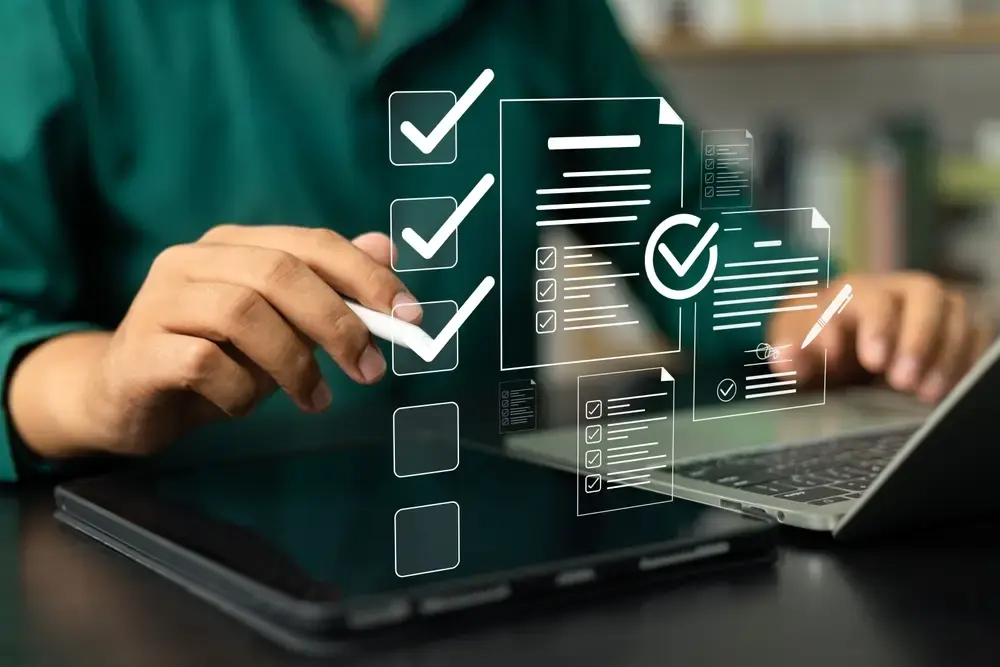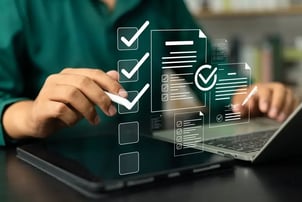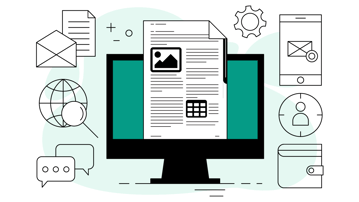The higher the contract value, the more rigorous the evaluation. Using a checklist helps ensure you submit a complete, accurate, and responsive proposal. By focusing your efforts, it can also help you boost your selection score and improve your chances of winning.
Benefits of Process Templates
Responding to tenders is often chaotic. They involve complex requirements, a variety of experts and a wide variety of submission documents - and often tight deadlines. With so much on your plate, it's normal to feel stressed or anxious.
Unfortunately, this stress can lead to overlooked details, slipped milestones and missed deadlines.
A comprehensive to-do list helps you overcome the overwhelming nature of proposals. It helps you better manage your workload, stay on top of the details, and avoid any last-minute scrambles for information.
- Avoid Missing Documents: Avoid doubts and disqualification.
- Reduce Errors: Reduce errors, omissions and contradictions.
- Increase Efficiency: Prioritize tasks and streamline document gathering.
- Boost Confidence: Minimize risk and reduce anxiety.
- Reduce Stress: Avoid last-minute scrambles for information or documents.
Tender Document Checklist
Think of this as an itinerary. It helps you plan and execute your proposal management tasks and confirm you are prepared to submit. While the requirements can vary, this list covers the typical required tasks.
Analyze the ITT
Competitive proposals require a thorough review of criteria and requirements. A to-do list guides your analysis as you read and uncover the crucial information you need, such as:
- Scope of work
- Job Requirements
- Evaluation Criteria
- Vague Language
- Pricing Structure
- Charging Mechanism
- Penalty Mechanism
- Incentives
- Terms and Conditions
- Submission Criteria
Analyze the Fit
You’ve analyzed the requirements and it sounds like a great opportunity for your business. However, there are costs associated with responding, and it’s only worth it if you can deliver and achieve your desired return on investment. In today’s highly competitive environment, businesses typically go through a standard bid/no bid, or go-no-go, process to confirm the client and project is a good fit for the business. For example, ask yourself:
- Does the project align with our strategic goals and objectives?
- Do we have the capabilities and capacity to fulfill the contract?
- Do our strengths outweigh those of our competitors?
- Is the chance of winning worthy of the investment at this time?
- Are the potential financial, operational, and delivery risks worth the investment now?
- Who is the competition, are they already working with the client, and how do we compare?
- Do we have the references to demonstrate our capabilities?
- Will we have to engage a partner or supplier?
Pursuit Strategy
A well-defined pursuit strategy helps your team develop a tailored and impactful proposal, one that is more likely to engage and impress the client. By preparing this now, your team will know what to write, and you’ll tell a more compelling story that positions your business as the ideal partner. Communicate your strategy by pulling together:
- Client and Project Pains, Goals and Desired Outcomes
- Approach (Or, how you will capture the client’s attention and solve their problem)
- Value Proposition
- Strengths and Weaknesses
- Competitive Analysis
- Differentiators and Discriminators
- Storyboard of the Narrative (Including how you will tell the story visually)
- References and Other Evidence
- Concerns or Objections and How to Counter Them (And how to interpret vague requirements)
- Specific Decision-maker and Influencer Pains, Goals, and Aspirations
Plan Tasks
A proposal often involves a substantial contract. Effective planning helps you position your team, and your business, to succeed at the selection process. A checklist helps ensure you are prepared to kick-off your effort and begin writing. Plan for kick-off by preparing:
- Win Themes and Key Messaging
- Resources (Experts, writers, graphic designers, legal, finance, management, quality assurance, health and safety, procurement, engineering, operations, logistics, IT, suppliers or contractors)
- Job Requirements, or Roles, Responsibilities, and Tasks (Write, Review, Approve, Production, Delivery)
- Content Dependencies
- Milestones and Deadlines
- Budget (Resources and Materials)
- Selection Requirements
- Competitive Analysis
- Writer's Package (Guidance on how to respond)
- Response Template
- Additional Documents (Testing or Simulations, Environmental Impact Assessment, Health and Safety Plan, Quality Management Plan, Diversity and Inclusion Statement, Sustainability Plan)
- Price Modeling
- Graphic Design
- Job Scheduling
- Contract Review
- Submission Requirements and Production Plan
- Delivery Plan (Including any packaging requirements)
- Kick-off Meeting
- Clarification Questions (Or interpretations)
Gather Administrative Documents
Administrative documents help evaluators assess your credibility, experience, and ability to deliver on the project. The key is to communicate that you are the best suited vendor to deliver on the project while minimizing the risks. For example, prepare these documents early in the process:
- Cover Letter
- Tender Submission Form
- Declaration of Interest
- Certification of Incorporation
- Financial Statements
- References
- Insurance Certificates
Compile Proposal Documents
Proposal documents provide evaluators with detailed information about your proposed solution, approach, and qualifications. The main point of each is to show that you understand the project, and prove that you have the skills to complete it. Remember, follow the required outline, for example:
- Executive Summary
- Introduction and Company Overview
- Scope of Work
- Methodology and Approach
- Project Timeline and Milestones
- Resource Allocation and Staffing
- Pricing and Payment Terms
- Risk Assessment and Mitigation Plan
- Appendices (Case Studies, Testimonials, Supporting Documents)
Gather Additional Required Documents
Additional required documents will vary depending on the specific opportunity, project and industry. The key here is to be thorough, accurate, and relevant. Some common examples of additional required documents include:
- Environmental Impact Assessment
- Health and Safety Plan
- Quality Management Plan
- Diversity and Inclusion Statement
- Sustainability Plan
- Testing or Simulations
Kick-off Meeting
The kick-off meeting typically occurs within two to three days of receiving the ITT. The key to success is communicating the client and project details, pursuit strategy and team responsibilities. However, the kick-off is also an opportunity to align your team and cultivate collaboration. An effective kick-off meeting includes:
- Welcome and Emphasize the Team's Contribution to Success
- Client and Project
- Pursuit Strategy
- Tasks and Content Dependencies
- Milestones and Deadlines (Including different deadlines for different submissions)
- Clarification Questions
- Partners or Suppliers
- Schedule Conflicts
- Resource Reallocation
- Information and Collaboration Platform
- Follow-up (Confirm meeting and any updates, and submit clarification questions)
Monitor Status and Progress
Touching base with your team on a regular basis is vital to keeping your development on track, especially when your resources are decentralized. As priorities and schedules shift, you may need to reallocate resources to head off bottlenecks and meet your deadlines effectively. It is also a good time to confirm content development is in sync with the pursuit strategy and to address any questions or concerns. A standard stand-up meeting might include:
- Task Status and Progress
- Schedule or Content Challenges
- Pursuit Strategy or Content Questions
- Resource and Schedule Adjustments
- Feedback and Coaching
- Clarification Updates
- Amendment Updates
- Next Steps
Production and Submission
A professional tender proposal demonstrates your attention to detail, project commitment and work ethic. These qualities make a great first impression during the evaluation process. Be sure to allocate enough time to produce an accurate and professional submission package. Plan your production time by considering:
- Gather and Compile Documents (Reformat to your proposal)
- Proofread for Compliance and Accuracy
- Format Consistently (Following tender and brand guidelines)
- Confirm or Update Graphics
- Organize Volumes (According to guidelines, price vs no price volumes, etc.)
- Double-check Headers and Footers
- Test Print (Confirm layout, formatting and pagination)
- Organize Electronic Files (Following guidelines for online, portal submissions)
- Package and Deliver
Post-Submission
Once you have submitted your proposal, it’s important to monitor its progress and confirm its delivery. It’s also the right time to discuss the experience with your team and identify how the process can perform better for them on the next proposal.
- Confirm Submission
- Track Submission
- Feedback Analysis
- Lessons Learned
- Recognition and Rewards
- Client Debrief
- Adjust Process
- Update Content
Debrief Meeting
Win or lose, you want to know why. It can help you better understand what stood out, or didn’t, so you can adjust and improve your process, content, and communication. It’s also a great opportunity to build more meaningful relationships with the organization that can translate into positives on the next opportunity.
- Gather Information
- Meeting Objectives
- Questions for Feedback
- Key Takeaways
- Future Opportunities
Lessons Learned
Everyone who was involved in the proposal process should participate in the lessons learned meeting. Schedule time, focus on the facts to avoid personal bias, and use a checklist to guide the process. In the end, you’ll have an action plan to implement to address any issues and improve.
- Process: Were the right people involved? Were there any unexpected delays? Did we stay within budget? Were there any communication breakdowns?
- Content: Was the approach sound and did the proposal demonstrate the team’s relevant experience? Was the value proposition clearly articulated and differentiated?
- Lessons Learned: What went well and what could be improved?
Best Practices
You have a lot on your plate. You'd hate to overlook an important task, and then have to scramble for it at the last minute. A checklist is a valuable tool for completing proposal tasks accurately and efficiently. It also reduces risks and stress and the negative consequences of both.
Here are some best practices for tailoring your list:
- Flexibility: Structure your list to accommodate different tender types and sizes so you and your team can adapt quickly.
- Technology: Consider proposal management tools to organize your team, proposal, and supporting documents. Save time by skipping document parsing, compiling, and reformatting.
- Collaboration: Technology also centralizes content and content development, making it easier and faster for experts to connect and create more accurate and relevant content.
- Library: Consider organizing a content library for standard FAQs and supporting documents, as well as frameworks that guide more custom or tailored response development.
- Continuous Improvement: Things change fast. Always be looking for ways to enhance your process and improve efficiency and effectiveness.
A tender document checklist is an essential tool for ensuring you qualify and impress clients. By following these best practices, you can create a comprehensive and effective response document and stand-out. Even better, with the right RFP response software in place, you can streamline the entire process and win contracts at scale!












